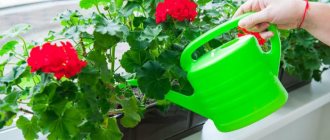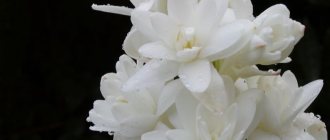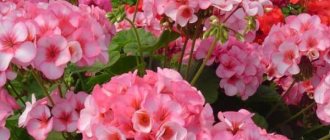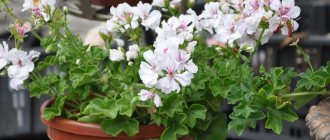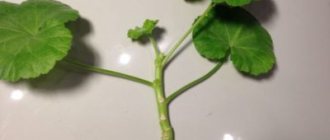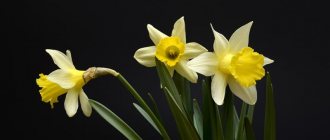We know geranium as an unpretentious indoor plant that delights with bright, numerous flowers from spring until winter. However, not everyone knows that there is another type of this flower that grows quietly in open ground. The hardy “sister” can be found in the garden, forest or marshy area. Botanists have divided them into two varieties, one of which is called “geranium” and the other “pelargonium”. It was the second that became the favorite of almost all gardeners. Both genera belong to the same Geranium family and have the same origin.
Features of winter and summer care for home geraniums
Geranium looks different in winter and summer. This is due to the length of the day and the need to give the plant a rest before the next flowering period.
In summer, protect pelargoniums from direct sunlight. In winter, choose the most illuminated window sill. If the apartment does not have south windows, use a phytolamp, extending the daylight hours to 12-14 hours. This way, the bush will retain its shape, the shoots will not lengthen, and the leaves will not fade.
The room temperature should be at least 22 degrees in summer and no more than 16 degrees in winter. Warmth will help pelargonium bloom magnificently in summer, and coolness in winter will allow you to get the necessary rest and gain strength.
By the way, pelargoniums tolerate ventilation well (not to be confused with drafts!), but not the dry heat of radiators.
In summer, during the flowering period, the plant should be watered more abundantly. In winter, when the geranium is dormant, watering should be moderate. This will prevent excessive soil moisture, which can cause root rot.
What to do with geraniums grown outside in autumn and winter?
Autumn can be very cold, especially in the pre-winter months, so don't risk leaving your geraniums outside. Plants can tolerate cold weather, but only to a certain extent. It is dangerous to expose pelargonium to night frosts and negative temperatures. It may freeze, which will lead to irreversible consequences.
In order to preserve the plants in time and lay the foundation for future flowering, they must be sent for the winter. To do this, you need to put the pelargonium on the balcony, porch, cellar, warm garage or basement. If it grows in a pot, there will be no problems with carrying it. And when grown in open ground, geranium must be carefully transplanted into a pot with a root ball and left for the winter in an unheated room.
Wintering geraniums
Geranium pruning
This procedure can be carried out in autumn or spring, depending on the variety of pelargonium. Zonal pelargoniums, for example, can grow greatly, and if this does not bother you in any way, they do not need to be pruned. In this case, small plants should be left without pruning until spring. For variegated varieties, pruning is very stressful, so it is recommended to do it in the spring. Ampelous pelargoniums need to be pruned only if they grow excessively.
Important: Always remove faded inflorescences and yellowed leaves, regardless of the type of geranium, and pruning is an individual procedure for almost each variety. For small pelargoniums, pruning will not matter much, but for large plants it is very important.
Procedure for pruning pelargoniums in autumn
At the end of September, cut off absolutely all flowering shoots, regardless of whether they have bloomed or are still active. This will help the geranium preserve its resources for the winter.
Leaves that have already turned yellow and wilted or are just beginning to turn yellow are removed. Experienced gardeners recommend pinching them off rather than cutting them with scissors. In the latter case, only a few protruding roots remain.
For denser flowering in September, pelargonium should be pruned before the branches begin or just above the node (from 3 to 5 cm). Then the top cut shoots can be rooted as cuttings. You need to continue pruning the plant until it loses its beautiful, lush appearance.
If the plant is young, it should only be pinched, and this must be done in accordance with the following rules :
- Start pinching young plants after they reach a height of 5-6 cm.
- When the geranium grows another 5 cm, it should be pinched again.
- To get a spherical bush, you can trim it three times in the same way.
What does the plant look like?
Pelargonium is a representative of perennial herbaceous plants; sometimes it is possible to encounter shrubby species. Pelargonium grows from 30 to 80 cm . Erect stems with alternately growing leaves. In this case, the shape of the leaves will be different for each species - simple, palmately dissected, palmate.
Umbrella-shaped inflorescences. Flowers of cultivated species are larger than wild ones and have 2 large upper petals and 3 smaller lower ones. Pelargonium has a unique aroma inherent in each individual species, for example, nutmeg, chocolate, citrus.
Using hybridization, you can achieve aromas such as peach, lemon, cinnamon, pine, cedar, lilac flowers, rose, vanilla.
Let's summarize - the most important thing in caring for geraniums
Proper care is the key to growth and lush flowering. “Green friends” tolerate ventilation well, but cold drafts are dangerous for them. It is important to follow all recommendations during the first time after planting.
- The soil. To plant cuttings, use a mixture of sand and universal soil in a ratio of 1 to 2.
- A weak solution of potassium permanganate will disinfect the prepared soil from harmful microorganisms, parasites, and pests. Potassium permanganate solution can be replaced with boiling water. In this case, you must wait until the substrate cools down.
- If cuttings take root in water, you can add activated carbon to the water. This will reduce the chance of rotting.
- Lush bushes can be obtained by timely pruning. You can do this any time of the year.
- For the normal development of pelargonium in the room, it is necessary to maintain the temperature at +20 degrees Celsius.
- If the leaves begin to dry out during rooting, cover the container with the cuttings with polyethylene, film or a lid.
- It is more convenient to plant seedlings using plastic cups. A drainage layer must be laid at the bottom. In addition, drainage holes must be made.
- A lack of light will quickly lead to a loss of lushness, and the bushes will become stunted. The location of pelargonium should be reconsidered. In summer, pots or flowerpots should be placed on the balcony. Bright light gives the leaves a reddish tint, which is not a sign of disease, it's just a "tan."
- Watering should be moderate and systematic. Spraying is not necessary. The main rule is to not allow the soil to dry out. Signs of this are yellowing of the leaves and their falling off. Avoid stagnation of water (do not allow the root system and neck to rot). Good drainage can help with this. In winter, watering is carried out less frequently. It is enough to water pelargonium 2-3 times every 4 weeks.
- The following fertilizers are suitable for geranium: phosphorus, nitrogen, potassium. With the right ratio of elements, your green pet will bloom profusely. You can use special fertilizers and complexes for this type of flowering plants.
- Pruning is a prerequisite for the proper development of pelargonium. The best time for this procedure is autumn. It promotes the formation of an elegant crown and greater tillering.
Rules for transplanting pelargonium
To replant geraniums, you need:
- Choose a larger pot than before. However, do not overdo it with space - too large a container will become a catalyst for the growth of foliage, not inflorescences;
- Provide the pot with drainage - add expanded clay, small stones or pieces of clay pots to the bottom;
- Before removing, water the plant well and carefully remove it from the pot;
- A layer of moist soil is poured into a new pot, a flower is planted in it, the space around the roots is filled with the remaining soil;
- Water no earlier than every 3 days.
A mandatory ritual in caring for pelargonium is cutting the stems. She especially needs this after winter. During a long cold period, the stems lengthen and the plant loses its attractive shape, so it is recommended to trim it, leaving 3-5 buds on the stem. To treat the cut site, colloidal sulfur, crushed coal or fungicide are used.
Main types: names, descriptions and photos
Currently, there are about 280 species of pelargonium . The following types are most popular among gardeners.
Zonal
This species can be either small (about 10 cm) or large (up to 1 m). Flowers can be two or three colors. A peculiarity of this species is that the petals may have a dotted pattern or a darker egg-shaped spot.
The shades of the inflorescences can be very diverse - all shades of red, as well as pink, white, cream, yellow and even several colors.
Varieties of Zonal Pelargonium:
- Alice.
- Bolero.
- Flamenco.
- Connie.
- Fantasy.
Royal
The most whimsical and beautiful look. This species got its name for its large flowers (up to 8 cm in diameter) with a non-uniform color, complemented by dark secretory spots or stripes, as well as with a wavy edge.
Varieties of Royal Pelargonium:
- Princess of Wales.
- Turkish.
We invite you to watch a video about Royal Pelargonium:
Angel
Small (up to 30 cm) plants with flowers similar to pansies. Less whimsical and continue to bloom all summer.
Pelargonium varieties Angel:
- Black night.
- Angelys Bicolor.
- Madame Layall.
Ivy-leaved
This species has a peculiarity - dark green leaves, reminiscent of the shape of ivy leaves. The inflorescences are most often double, and the color palette is represented in shades from milky to lilac and red.
Varieties of Ivy Pelargonium:
- Crock-o-day.
- Ice rose.
Fragrant
The most fragrant type, because when you touch the double flowers and leaves, you can feel a persistent aroma. Some varieties may have corrugated leaves. The flowers are often not particularly attractive - small in size and dull in color.
Varieties of Fragrant Pelargonium:
- Diamond (pineapple).
- Chocolate Mint (mint).
- Attar of Roses (rose).
History of selection
Geranium was first brought to our region from England in the mid-17th century, so many believe that England is its homeland. But in fact, geranium is a native of the southern regions - India and the coast of Africa . From here it was brought to the countries of the Old World, where breeders began to develop new varieties. One of these varieties is black geranium.
Interesting! American breeders bred black geranium, for which they received a prize in the field of breeding.
Diseases and pests, combating them
If the rules of care at home are violated, pelargonium grandiflora is affected by diseases and pests. In this case, it is recommended to treat the plant with chemicals to prevent the death of the flower.
Common diseases:
- powdery mildew;
- rust;
- leaf spot;
- root rot.
For treatment, it is recommended to use drugs such as “Horus”, “Skor”, “Topaz”, “Maxim”, “Previkur Energy”.
Pelargonium of this species is susceptible to aphids and whiteflies. To get rid of these pests, it is recommended to spray the bush with the working solution of “Aktellika” and “Fitoverma”, and also water it with “Aktara”
Pelargonium grandiflora is a prominent representative of the Geraniaceae family. It is distinguished by unusually beautiful flowers. But difficulties in growing it are associated with the plant’s increased demands on living conditions. Therefore, only experienced flower growers who are able to follow all the recommendations can cope with them.
Beneficial features
This plant has many beneficial properties, so it is also used in medicine and cooking.
The most commonly used are fragrant and pink pelargonium.
Cooking
- Since many varieties of pelargonium have a pleasant aroma, their leaves and flowers are used in the preparation of compotes, added to vodka, brandy, frozen in ice, added and decorated with desserts.
- Antiseptic properties are used when making jam to prevent mold.
Medicine
The leaves help normalize the heartbeat, stimulate blood circulation, and stop bleeding.- The plant has the ability to stimulate the digestive system, liver and kidneys.
- The leaves are used in the prevention of colds, and are also used in the treatment of otitis media, radiculitis and osteochondrosis.
- This plant helps cope with headaches and toothaches, and is also used as an antidepressant.
very carefully when treating children, avoiding ingestion .
Pensioners and people with chronic diseases should check with their doctor before using medications that contain pelargonium.
Find out more about the medicinal properties of pelargonium and its use in folk medicine here.
